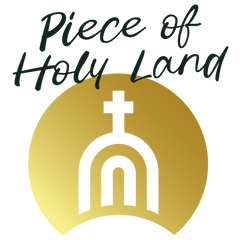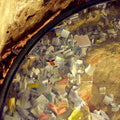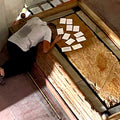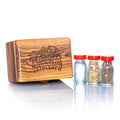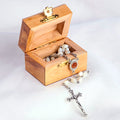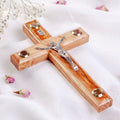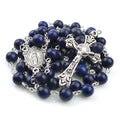What is the Holy Land? A Complete Christian Guide

The Holy Land – History, Faith, and Living Connection
Biblical Roots of the Holy Land
The Holy Land is not an abstract idea; it is the actual stage upon which salvation history unfolded. From Abraham’s covenant and the voices of the prophets to the Gospels’ eyewitness testimony, the narrative of God’s promise is anchored in real cities, real hillsides, and real waters. Bethlehem, Nazareth, the Sea of Galilee, and Jerusalem endure as living signposts, reminding Christians that the Incarnation happened in a specific place and time. That tangible geography is why pilgrimage feels so different from reading alone: kneeling in Bethlehem’s grotto or standing at the Galilee shoreline makes scripture visceral.
For readers who want to ground their study with direct citations, classic concordances and full-text search tools such as Bible Gateway help map verses to the very places Christians still visit today. And if you want an immediate deep dive into a single site that embodies this whole idea, see your own long-form feature on The Church of the Nativity in Bethlehem.
Grotto of the Nativity
Scripture in the Landscape
From Genesis to Revelation, the Bible is anchored in place:
- Bethlehem (“House of Bread”) fulfills Micah’s prophecy (Mic 5:2) when Christ is born there (Lk 2:1–20).
- Nazareth witnesses the Annunciation (Lk 1:26–38) and Jesus’ hidden years.
- The Sea of Galilee is the stage for preaching and miracles (Mk 4–6).
- The Jordan River—crossed by Israel into promise (Josh 3)—becomes the water where Jesus is baptized (Mt 3:13–17).
- Jerusalem holds the Upper Room, Gethsemane, Golgotha, and the empty tomb (Lk 22–24; Jn 18–20).
Walking these places is like reading the Gospel with your feet.
Early Christianity and the Pilgrimage Tradition
From the first centuries, believers risked rough roads, war-scarred borders, and long sea passages to venerate the places tied to Christ’s life, passion, and resurrection. After Christianity was legalised in the fourth century, basilicas rose above caves, tombs, and remembered stations of the Cross; way-finding for pilgrims matured into a tradition that has never really stopped. Pilgrimage, then and now, is not religious tourism, it is a spiritual discipline of presence: to walk, pray, and receive grace where the Church has remembered the mighty acts of God.
Today, the custom adapts to modern realities. Many travel in groups; others cannot travel at all. The Church, however, remains creative in widening the path. If a physical journey isn’t possible this year, you can still participate through reverent practices that keep the bond alive, like arranging a candle and intention at the Holy Sepulchre via the site’s Prayer Requests Service, and by weaving Holy Land devotions into your daily prayer rule at home.
The Holy Sepulchre Church Mosaic
![]()
Spiritual Symbols of the Holy Land
The land speaks through materials that Christians have treasured for centuries. Olive trees—themselves symbols of endurance, peace, and anointing—yield wood that artisans in Bethlehem shape into crosses, crucifixes, and devotional objects. Holding one is not superstition; it’s embodied remembrance: the faith is historical, and matter matters. Explore finely crafted pieces in the curated Olive Wood Crosses showcase.
Water is another powerful sign. Drawing from Nazareth and the Jordan River recalls both the Annunciation’s “yes” and Christ’s baptism, inviting believers to bless their homes and daily life. If you’re building a small home prayer corner, start with the Holy Water collection and a simple standing cross; add a candle for feast days. For contemplative prayer, a Rosaries collection tied to Holy Land origins helps the mind rest on mysteries while hands follow a rhythm known to saints across centuries.
The Holy Land Today
Modern pilgrims encounter a dynamic mosaic: ancient churches animated by today’s liturgies, neighbourhoods layered with cultures, and hospitality shaped by families who have stewarded sacred craft for generations. A typical day might include the Via Dolorosa at dawn, the Garden of Gethsemane by late morning, and vespers echoing through stone at dusk. In Nazareth, the Basilica of the Annunciation gathers the Gospel’s opening chapters into a single, breathtaking space; along the Sea of Galilee, the Sermon on the Mount can feel like it’s happening again in the hush.
If you’re planning a first journey, practical orientation from the Israel Ministry of Tourism helps translate devotion into itinerary. If you’re anchoring at home this season, remain connected through a modest devotional kit, holy water, a comfort cross, and a rosary, and, when you have a special intention, submit it through the Prayer Request Service. The point is not to “collect objects,” but to sustain a living relationship with the places that formed our faith.
The Role of Jerusalem in Christian Faith
Jerusalem concentrates the Gospel’s climax into a walkable radius: the Upper Room, Gethsemane, the Praetorium, Golgotha, and the empty tomb are not metaphors but addresses. To pray there is to let the Paschal mystery wrap around you in four dimensions, space, time, memory, and sacrament. The Church of the Holy Sepulchre, layered by centuries of rebuilding and reconciliation, embodies a core Christian truth: the Church is diverse, sometimes messy, yet united at the tomb from which life burst forth.
Because Jerusalem can feel overwhelming on a first visit, focus on depth rather than breadth. Choose one or two moments, an hour of silent prayer at the Stone of Anointing, Stations of the Cross before sunrise, and let them do their slow work. When you return home, keep that grace awake with tangible reminders: a small crucifix placed near your prayer corner or a Comfort Cross that fits the hand, picked up whenever anxiety rises and surrendered in prayer.
Chapel of the Franks, the 10th Station of the Via Dolorosa in Jerusalem

Bethlehem, Nazareth, and Galilee: Living Testimonies of Scripture
Bethlehem marks the humility of the Incarnation: God comes small, local, and vulnerable. Nazareth is the long fidelity of hidden years, the daily obedience and holiness that prepares public mission. Galilee is movement and mercy: sermons on hillsides, healings on the margins, storms calmed with a word. Together, these places sketch a spiritual pattern for Christians today: begin in humility, persevere in ordinary faithfulness, and then carry mercy outward.
If you’re teaching children the faith, let these three locales structure your catechesis: set a nativity scene that highlights the poverty of Bethlehem; hang a simple wall cross to “sanctify the ordinary” in Nazareth’s spirit; use a map of Galilee to show where Jesus called the first disciples. For gifts that reinforce the lessons, pair a nativity ornament with an Olive Wood Cross and a child-friendly rosary from the Rosaries collection. Families often find that simple, repeated gestures plant deeper roots than occasional “big moments.”
Final Reflection
The Holy Land is more than history, it is the living heart of Christian faith. Its sacred sites, traditions, and symbols continue to unite believers across the world, reminding us that God’s story unfolded here and still speaks today. Whether through pilgrimage, prayer, or sacred gifts made by hand in Bethlehem and Jerusalem, every Christian can draw nearer to the blessings of this land. Explore our Christian gifts from the Holy Land and keep its enduring spirit close to your walk with Christ.
Frequently Asked Questions about the Holy Land
Q: Why is the Holy Land important to Christians?
The Holy Land is the setting of God’s covenant, the life and ministry of Jesus, and the foundation of the Church. It holds the places where salvation history was fulfilled, making it the ultimate pilgrimage destination.
Q: What are the main holy sites in Jerusalem?
Jerusalem is home to the Church of the Holy Sepulchre, Mount of Olives, Via Dolorosa, and Garden of Gethsemane, each linked to Christ’s passion and resurrection.
Q: Can I buy authentic Christian gifts from the Holy Land?
Yes, artisans in Bethlehem, Jerusalem, and Nazareth create Olive Wood Crosses, Rosaries, and Comfort Crosses. Stores like Piece of Holy Land ensure authenticity and connection to local tradition.
Q: What is the significance of olive wood in Christianity?
Olive trees symbolise blessing, endurance, and peace. Olive wood from Bethlehem, carved into crosses and devotional items, carries the biblical spirit of the land where Christ was born.
Q: How do prayer requests work at the Church of the Holy Sepulchre?
Through services like ours, a candle is lit and prayers are offered inside the church in your name, uniting you with the holiest Christian site even from afar.
Q: Are pilgrimages to the Holy Land safe today?
Millions of Christians visit each year. It is recommended to join organised pilgrim groups and check official advisories, such as the Israel Ministry of Tourism.
Q: What is the meaning of Holy Water from Nazareth and the Jordan River?
Holy Water recalls Christ’s baptism and the life of Mary. It is used for blessings, spiritual protection, and devotion in Christian homes around the world.
Q: What are the best Christian gifts to bring home from the Holy Land?
Treasured items include Olive Wood Crosses, Rosaries, and Holy Water, all crafted with care by local artisans and infused with the spirit of the land.
SHARE:

